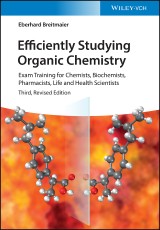Details

Efficiently Studying Organic Chemistry
Exam Training for Chemists, Biochemists, Pharmacists, Life and Health Scientists3. Aufl.
|
43,99 € |
|
| Verlag: | Wiley-VCH |
| Format: | |
| Veröffentl.: | 25.04.2022 |
| ISBN/EAN: | 9783527838493 |
| Sprache: | englisch |
| Anzahl Seiten: | 320 |
DRM-geschütztes eBook, Sie benötigen z.B. Adobe Digital Editions und eine Adobe ID zum Lesen.
Beschreibungen
<b>Efficiently Studying Organic Chemistry</b> <p><b>Complete yet concise learning resource for organic chemistry exam training</b> <p>Based on the author’s extensive teaching experience, this unique textbook comprises the essentials of organic chemistry in 86 chapters as concise, self-contained units of study. Each chapter, visually presented as one or two double pages, includes questions to allow for immediate and effective self-examination. Answers are summarized in the appendix. <p> Topics covered within the book include: <ul><li>Basic concepts (atomic and molecular orbitals, covalent bonding, hybridization, resonance, aromaticity) </li> <li>Molecular structure (atom connectivity, skeletal isomerism, conformation, configuration, chirality)</li> <li>The classes of organic compounds including natural products, polymers, and biopolymers</li> <li>Types, mechanisms, selectivity, and specificity of organic reactions</li> <li>Molecular structure elucidation (mass spectrometry, UV and visible light absorption, IR and NMR spectroscopy)</li> <li>Planning organic syntheses</li></ul> <p>The perfect fit for bachelor and master students alike, this book is an all-in-one resource for efficiently studying and passing organic chemistry exams.
<p>Contents 1</p> <p>Preface 6</p> <p>Organic Chemistry 7</p> <p>1 Atomic Orbitals, Electronic Configurations 8</p> <p>2 Covalent Bonding 10</p> <p>3 Hybridization of Atomic Orbitals 12</p> <p>4 Covalent Carbon-Carbon Bonding 14</p> <p>5 Alkanes 16</p> <p>6 Skeletal Structure, Structural Isomerism 18</p> <p>7 Basic Rules of Nomenclature 20</p> <p>8 Drawing Molecular Structures 22</p> <p>9 Conformation 24</p> <p>10 Reactive Intermediates 26</p> <p>11 Basic Types of Organic Reactions 28</p> <p>12 Energy Turnover of Chemical Reactions 30</p> <p>13 Radical Substitution 32</p> <p>14 Alkenes, Skeletal and Configurational Isomers 34</p> <p>15 Synthesis of Alkenes 36</p> <p>16 Additions to Alkenes 40</p> <p>17 Dienes 44</p> <p>18 Additions and Cycloadditions with 1,3-Dienes 46</p> <p>19 Alkynes 48</p> <p>20 Cycloalkanes 52</p> <p>21 Basic Syntheses of Cycloalkanes and Cycloalkenes 56</p> <p>22 Reactions of Cycloalkanes and Cycloalkenes 58</p> <p>23 Benzene, Aromaticity, Aromatic Compounds 60</p> <p>24 Benzenoid Aromatic Compounds 62</p> <p>25 Electrophilic Substitution of Benzene 64</p> <p>26 Electrophilic Second Substitution of Benzenes 66</p> <p>27 Other Reactions of Benzenoid Aromatics 68</p> <p>28 Polycyclic Benzenoid Aromatic Compounds 70</p> <p>29 Non-benzenoid Aromatic Compounds 74</p> <p>30 Alkyl Halides 76</p> <p>31 Mechanisms of Nucleophilic Substitution 80</p> <p>32 Organometal Compounds 82</p> <p>33 Alcohols 84</p> <p>34 Diols, Triols 88</p> <p>35 Reactions of Alcohols 90</p> <p>36 Dehydration of Alcohols 92</p> <p>37 Ethers 94</p> <p>38 Amines 96</p> <p>39 Reactions of Amines 98</p> <p>40 Diazo and Azo Compounds 102</p> <p>41 Carboxylic Acids 106</p> <p>42 Carboxylic Acid Derivatives 110</p> <p>43 Substituted Carboxylic Acids 114</p> <p>44 Absolute Configuration 118</p> <p>45 Enantiomers without Carbon as Stereogenic Center 122</p> <p>46 Diastereomers 124</p> <p>47 Aldehydes 126</p> <p>48 Ketones 130</p> <p>49 Carbonyl Reactions 132</p> <p>50 CH Acidity of Carbonyl Compounds 136</p> <p>51 1,3-Dicarbonyl Compounds 138</p> <p>52 Phenols 142</p> <p>53 Quinones 146</p> <p>54 Organosulfur Compounds 150</p> <p>55 Carbonic Acid Derivatives 154</p> <p>56 Heterocumulenes 158</p> <p>57 Rearrangements 160</p> <p>58 Polymers, Polymerization 164</p> <p>59 Syntheses with Organosilicon Compounds 168</p> <p>60 Heteroalicycles 170</p> <p>61 Five-Membered Aromatic Heterocycles 174</p> <p>62 Six-Membered Aromatic Heterocycles 178</p> <p>63 Benzo-Fused Five-Membered Heteroaromatics 182</p> <p>64 Benzo-Fused Six-Membered Heteroaromatics 186</p> <p>65 Fused Aromatic Heterocycles 190</p> <p>66 Absorption of Light, Color, Dyes 194</p> <p>67 Porphyrinoids 198</p> <p>68 Amino Acids 200</p> <p>69 Peptides, Proteins 202</p> <p>70 Alkaloids 206</p> <p>71 Carbohydrates: Aldoses and Ketoses 208</p> <p>72 Carbohydrates: Oligo- and Polysaccharides 212</p> <p>73 Nucleic Acids: DNA and RNA 214</p> <p>74 Lipids 216</p> <p>75 Polyketides 218</p> <p>76 Terpenes 220</p> <p>77 Steroids 224</p> <p>78 Selectivity and Specificity of Organic Reactions 226</p> <p>79 Prochirality, Enantioselectivity 230</p> <p>80 Planning Organic Syntheses 232</p> <p>81 Aspects of Molecular Structure 236</p> <p>82 Mass Spectrometry 238</p> <p>83 Infrared Spectroscopy 240</p> <p>84 Nuclear Magnetic Resonance: Proton NMR 242</p> <p>85 Nuclear Magnetic Resonance: Carbon-13 NMR 246</p> <p>86 Nuclear Magnetic Resonance: Two-Dimensional NMR 248</p> <p>Working on Questions 250</p> <p>Subject Index 295</p> <p>Periodic Table of the Elements 314</p> <p>Selected Reference Sources 316</p>
<p><b>Eberhard Breitmaier</b> received his PhD in 1966 at the University of Tübingen, Germany. After a postdoctoral fellowship followed by an appointment as assistant professor for organic chemistry at the University of Houston, Texas, USA, from 1967 to 1968, he gained his lecturing qualification (habilitation) at the University of Tübingen in 1971. He was professor for organic chemistry and instrumental analysis at the University of Bonn, Germany, from 1975 to 2004. His research focused on 3-alkoxyacroleins as reagents for organic synthesis, porphyrinoid annulenes, and natural products. He has authored many scientific publications and several textbooks on organic chemistry, NMR spectroscopy, and natural products.</p>
<p><b>Complete yet concise learning resource for organic chemistry exam training</b></p> <p>Based on the author’s extensive teaching experience, this unique textbook comprises the essentials of organic chemistry in 86 chapters as concise, self-contained units of study. Each chapter, visually presented as one or two double pages, includes questions to allow for immediate and effective self-examination. Answers are summarized in the appendix. <p> Topics covered within the book include: <ul><li>Basic concepts (atomic and molecular orbitals, covalent bonding, hybridization, resonance, aromaticity) </li> <li>Molecular structure (atom connectivity, skeletal isomerism, conformation, configuration, chirality)</li> <li>The classes of organic compounds including natural products, polymers, and biopolymers</li> <li>Types, mechanisms, selectivity, and specificity of organic reactions</li> <li>Molecular structure elucidation (mass spectrometry, UV and visible light absorption, IR and NMR spectroscopy)</li> <li>Planning organic syntheses</li></ul> <p>The perfect fit for bachelor and master students alike, this book is an all-in-one resource for efficiently studying and passing organic chemistry exams.

















